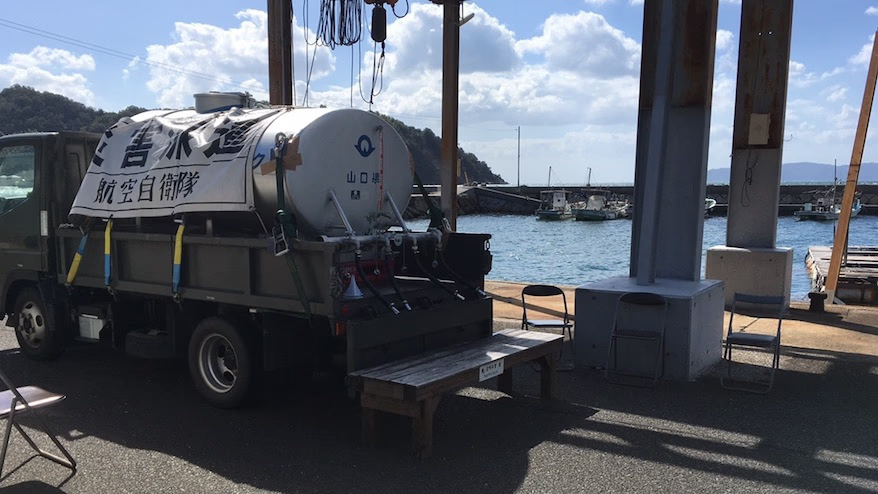周防大島サテライト勤務、副社長の永井です。今年の周防大島は、ニュースが多かった!
「永井さんが周防大島に行くまで地名すら知らなかったけど、意識して見てるとニュースにも結構出るんだね」なんて話をしてくれる方もいますが、去年までの周防大島は、テレビの全国放送に出るといったら、夏のサタフラ(夏休み中の毎週土曜に開催、サタデーフラダンス)か、冬のみかん鍋(みかんを丸ごと鍋に入れちゃいます)くらいだった、のどかな島。
それなのに今年は、島内で子どもが行方不明になってスーパーボランティアおじさんが活躍したり、大阪からの逃走犯が島内の道の駅に潜伏していたりなど、Yahooニュースにも取り上げられるほどの出来事がいくつもありました。
そして、2018年も終わろうとしているこの時期、最大の事件が起こってしまいました!
本州と島を結ぶ大切な「大島大橋」に船が衝突!
40年以上前から周防大島と本州と結ぶ約1kmの大島大橋。その橋の下を、10月22日未明、橋の高さより10メートル以上も高いマストを持った大型外国船が無理やり通過しようとして、橋に設置された送水管やインターネット回線が破断され、橋本体までもが危うい状態になってしまったのです。
その日、私は東京にいたのですが、島にいる夫の情報では、インターネットは半日ほどで復旧したものの、上水道は復旧せず、橋も片側通行の通行規制は続くとのこと。翌日帰宅予定でしたが、「帰ってこないほうがいいかもよ」とまで言われる始末。とはいえ、戻らないわけにもいかず・・・。
これを書いている時点(11月12日)では、事故からちょうど3週間経っています。けれど、島全体がまだ給水車のお世話になり、橋は片側通行で大型車は通行不可。ちょっと風が強いとすぐに全面通行止めになっている状況です。
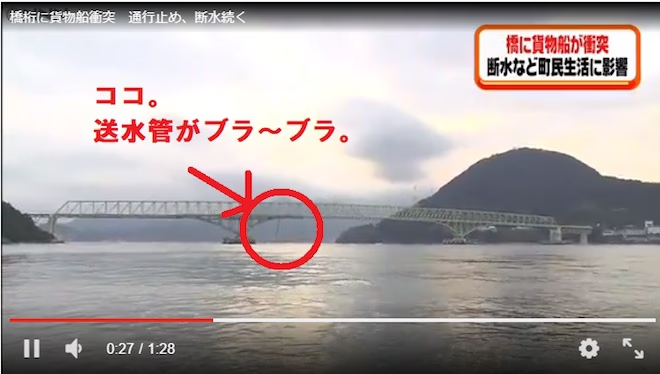
出典:Yahoo!ニュース(https://headlines.yahoo.co.jp/videonews/nnn?a=20181023-00000032-nnn-soci)
緑のフォルムが美しい大島大橋。島民の大切な生活道路であり、水やインターネット回線を本州から通している大切なインフラです。また、車で気軽に行ける離島だからこそ、大勢の観光客にも人気の場所になっています。
水道から水が出ない生活?!
リアルには想像できていませんでした。
水道から水が出るというのは、私たちにとって、もう当たり前になってしまった生活です。
だから、断水が始まったころは、水が出ないとわかっているのに、歯磨きをした後に無意識に蛇口をひねってしまったり、トイレ後に、無意識にウォッシュレットボタンを押してしまったりすることも多くありました。
あっ、出ない。
そうだ、断水だった。。。
これまでニュースで被災地などが取り上げられて、給水車に並ぶ人たちの姿を見たり、水がなくて大変というコメントを聞いたことはあっても、自分の生活がそうなったら・・・という意識で考えたことはありませんでした。
いかに当たり前に水道から水が出ていたのかを思い知らされます。
そんな中、いろいろな生活の工夫が始まりました。
まず洗面所には、「手洗い用」「飲んだり歯磨き用」「トイレ用」の3つの水を用意。
水が止まると、水洗トイレもバケツで水を流さないといけないのは何となく知っていましたが、お風呂も給湯は仕方ないにしても追い炊きすらできないとは!そこで、水を温めるヒーター(夫の実家にあったものを送ってもらいました)、洗濯用の残り湯をくみ出すポンプ、庭に水を撒く散水用シャワーヘッドという、身近にあったいろいろな器具を駆使して、自家製シャワーの完成です!
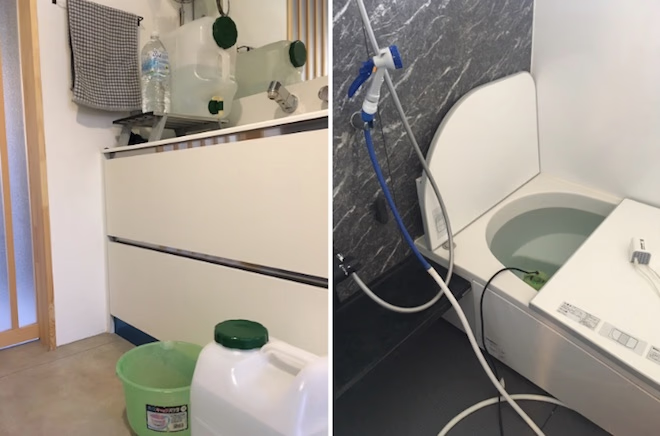
水タンクだらけの洗面所(左)と、工夫いっぱいwのお風呂(右)
また、給水車に水をもらいに行くうちに、「1日に自分たちが使っている水の量」が、だんだんわかるようになってきました。
・シャワーは男女2人分で、約30リットル(かなり節約)
・炊事等々含めて、節約しつつある程度普段通りの生活をするのに、1日70~80リットル。
・加えて洗濯をする日は、1回分約80リットル。
さすがに、お風呂(湯舟にお湯を張って浸かる)は約200リットルなので、断水中はあきらめます。(浴室暖房があるお風呂にして良かった!)
こうして見ると、1日けっこうな量を使っています。
そして、水は重い。
10リットルだってヨタヨタしながらの運搬です。20リットル・・・私には、給水車からもらった水を自分の車に運び込む5mの移動も無理です。あー結婚していてよかった?!
周防大島だからこそ?意外にやれた、断水1ヶ月。
けれど意外に、生活はのん気なところもあります。
最初のころは、「食器を洗わなくていいインスタント食品がいいかな」「お皿にラップを敷いたら1回1回洗わなくてもいいらしい」とか、いろいろ考えましたが、長期戦で行くには、美味しいものを美味しく食べて元気でいることも大事!そう考えて、割と早めに普段とほぼ変わらない食生活に戻りました。
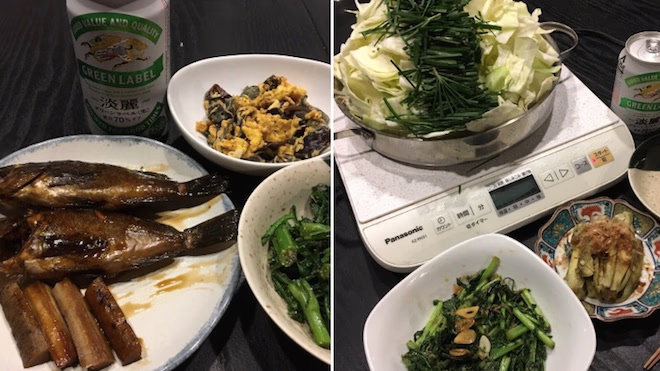
断水中の晩ごはんを少しご紹介すると…給水に行って会ったご近所さんに、山で取れたキクラゲをもらい、卵とじに。左の写真のメバルは釣って、青菜は畑から。またある日は、もつ鍋。山口県は九州博多に近いせいか、食文化も似ているようで、新鮮なモツが手に入りやすいのです。断水中は洗い物が少しでも減るよう、鍋率が高めです。
私たちは体力もあるので水も運べるし、車もあるのでいざとなったら橋を渡って何とでもなります。ただ、高齢化率が50%を超える周防大島町、お年寄りたちは水が出ない生活をどうしているのかと心配しました。
地域や人によってだいぶ様子は違うようで、ご苦労されている方々もたくさんいます。けれど、少なくとも私の住んでいる地家室では、昔の水道(山の湧き水らしい。本当は農業用水といいつつ、家に引いている人も多く、生活にも使っています)があるので、みんな意外に普段とそれほど変わらない生活のようです。
・車を持っていないおじいちゃん(推定90歳)
--- 断水になってるけど、水は大丈夫?
「断水?今日は釣りに行っちょった。イカ30匹目が釣れたんよ!」(旧水道と五右衛門風呂のお風呂が家にあります。たぶんトイレも「昔ながら」だから、生活自体はほぼ変わらないようです。)
・畑仕事から帰宅中のおじさん(推定70歳)
--- 今、井戸や湧き水の水質検査を無料でしてくれるそうよ。
「水質検査?昔っから飲んどる水じゃけ大丈夫やろー」(えっ農業用水だってばw まぁおなか壊さないならいっか。)
・いつもおかずを作ったりしてくれる隣のおばちゃん(推定65歳)
「給水車行ってるんだって?うちは昔の水道あるから、私が居なくてもうち入っていつでも使っていいからね。」(そう、外出時だって鍵なんてかけません。)
・給水車の番をしてくれていたおばちゃん(推定70歳)
「アラ〜大変よねぇ。いつまでもこんなじゃ、せっかく来てくれたのに大島が嫌いになっちゃわないかしら?(ケラケラ)」(なんだか普段会わない人ともしゃべれて楽しそう…?!)
もちろん、一人暮らしで体力の弱いおばあちゃんや、山の上のほうに家があるおばあちゃんもいます。そんな人たちには、60代の若者(!)が、水を運んであげています。
様子を見に行ったり、声をかけあったり。普段から「あそこのじいさんは腰を痛めたらしい」「あそこのばあさんは息子が1週間に1度だけ来れるんだ」とか、情報を細かくみんなで共有しているから、誰にどんな手助けが必要か、頼まれる前から把握しています。
・・・頼もしい。むしろ、車もあって体力もあるはずの私たちが、いちばん心配されていたかもしれません。
とくにサテライトオフィスのある地家室は、昔は近隣の地区に水を配っていたほどだそうで、地域の上流には良質でいつでも枯れない水源があるそうです。冒頭の写真のように、せっかく給水車がやって来ても、時間によっては水を求める人がおらず、拍子抜けするほどガラガラのことも。(「地家室の人は全然給水に来んけど、大丈夫?」と、役場の方から電話をもらうほど)もちろん、同じ周防大島内の給水所でも、2時間待ちなどの話も聞きますので、島内でも大きな地域差があるようです。
島内の友だち(移住3年、女子1人暮らし)に聞いてみても、「お隣さんが井戸水使えるので、お風呂は借りてる(親類でも何でもない、ただのご近所さん!)」「飲み水は運ばないとならないので、筋肉ついたわー」という感じで、どこも助けあいながら、やっています。
美容院やいくつかのレストランも、井戸水を使いながら営業しているところは多いし、観光の拠点「道の駅」もいち早く再開しています。
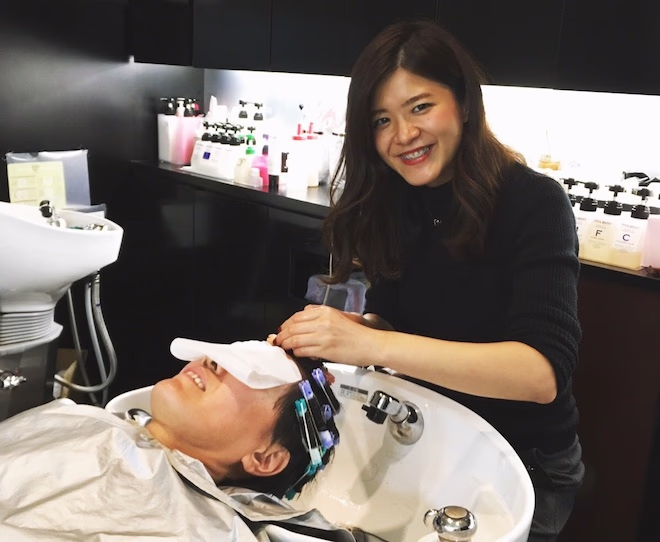
断水になって数日。行きつけの島の美容院に「さすがに予約してたけど無理よねー」と電話したところ、「営業してますよ~」とのまさかのお返事。聞けば、毎日、営業するために朝から井戸水を汲んで、沸かしておいてくださっているそうです。
東京だったらどうなっていたか…
断水を通して感じた、周防大島の底力
たしかに、今回の事故で私は生まれて初めて「水道が使えない」という不自由を体験しています。そして、周防大島内でも、大打撃を受けた人や苦労の多い生活をしている人が、たくさん、たくさんいます。
けれど、もしこれが東京で起こったら?
もちろん家の近くに井戸なんて無いし、車や水運び用の台車も持っていない人が大半です。
それに、隣の家に、お風呂を借りに行けるでしょうか?
隣に住んでいるおばあちゃんに、頼まれもせず当たり前に水を運んであげられるでしょうか?
この記事を書いている時点で、水道が復旧する見込みは、まだ1ヶ月近く後になりそうとのこと。橋の完全復旧は、来年4月になるという話もあります。
確かに、田舎だから、復旧が遅いということはあるのかもしれません。
そして、観光業の盛んなこの地域で、交通の不安と水道の不自由さから、観光客が激減しているレストラン、物販などのお店の大打撃は、計り知れないものがあります。
けれど、このような事件性のある水道管破壊は、よく考えたらどこで起きてもおかしくないこと。もし東京などの都市部で、これだけの期間、これだけの範囲での断水が起きたら、はたして不便なりにも生活を維持することができるのでしょうか。
暴動も起きず、死人も出ず(!)、旧来のインフラをうまく活用しながら、地域のみんなが助け合いながら頑張れる。起きてしまったことは受け入れ、時には怒り、時には冗談交じりに状況を笑い飛ばしながら、それぞれが前を向いてやれることを粛々と取り組む。
そんな、ここ周防大島の底力を感じたのも、今回の断水の大きな気づきになりました。
この断水と橋の全面的な通行規制解除は、まだもう少し先になりそうです。
それぞれができることをやり、足りないところを助け合いながら、乗り切っていければと思います。
がんばろう!周防大島「今だけの島産品ショップ」
https://peraichi.com/landing_pages/view/161p3?fb-181109&fbclid=IwAR0Wz3xSWgG3ZxU1YhyYc8VGdtCvaxvEtqiszQRPZ-KXS4-1Gn_IFIpqgcQ
東京のみんなは買って応援よろしくお願いします!
